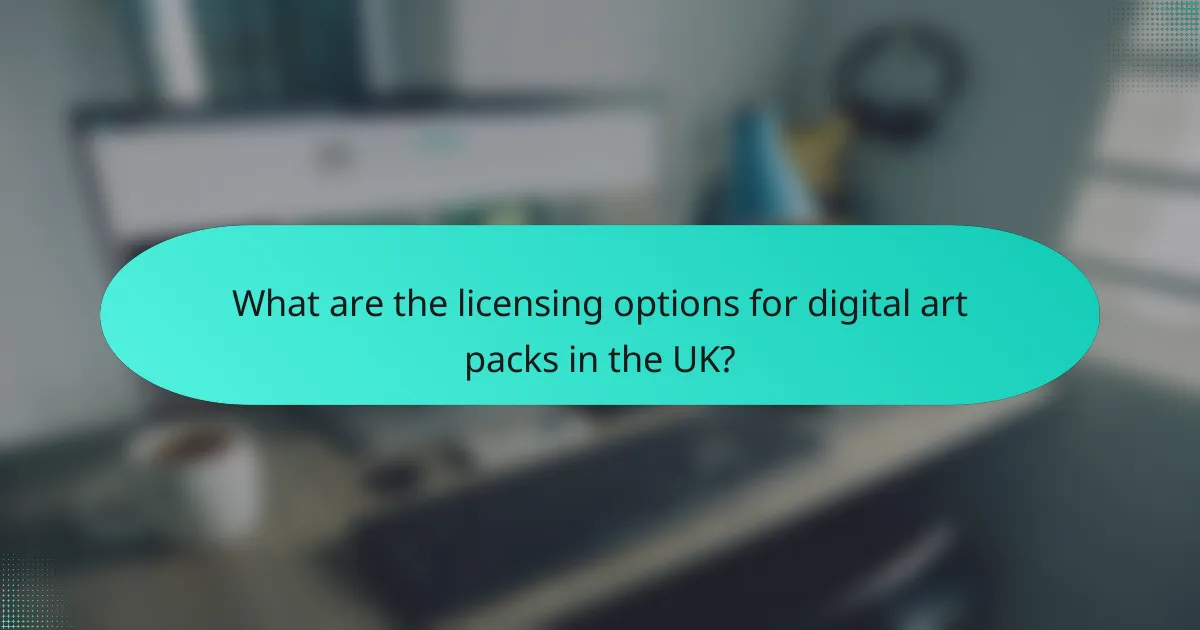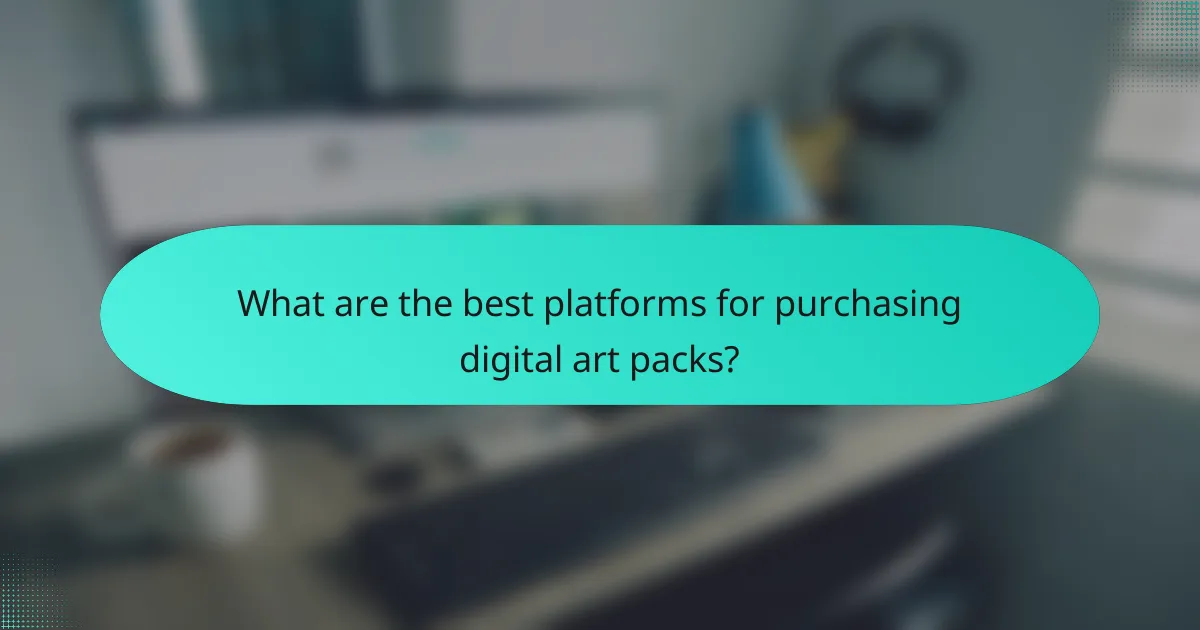Digital art packs offer a range of licensing options that are essential for both artists and buyers to understand, ensuring proper usage and value maximization. These packs serve as versatile tools for promotional use, enhancing brand visibility and engagement across various platforms. By exploring the best platforms for purchasing, such as Adobe Stock and Creative Market, users can find the right resources tailored to their needs.

What are the licensing options for digital art packs in the UK?
In the UK, digital art packs come with various licensing options that dictate how the art can be used. Understanding these options is crucial for both artists and buyers to ensure compliance and maximize the value of the artwork.
Royalty-free licenses
Royalty-free licenses allow users to purchase digital art packs and use them without paying ongoing royalties or fees for each use. Once acquired, the buyer can typically use the artwork for multiple projects, making it a cost-effective choice for businesses and individuals.
However, it’s essential to read the specific terms, as some restrictions may apply, such as limitations on resale or use in certain contexts. Always verify the license terms to ensure compliance.
Rights-managed licenses
Rights-managed licenses are more restrictive and require users to pay based on specific usage parameters, such as duration, geographic reach, and distribution size. This type of license is ideal for projects needing exclusive rights for a limited time or specific applications.
Buyers should consider their project needs carefully, as costs can vary significantly. For instance, a small local campaign may have a lower fee compared to a national advertising campaign.
Exclusive licenses
Exclusive licenses grant the buyer sole rights to use the digital art pack, meaning the artist cannot sell the same artwork to anyone else. This type of license is often more expensive but provides a unique advantage for brands seeking to differentiate themselves.
When negotiating an exclusive license, it’s crucial to clarify the scope of use and any potential limitations. Ensure that the agreement specifies the duration and any geographical restrictions.
Non-exclusive licenses
Non-exclusive licenses allow multiple buyers to use the same digital art pack, making them a more affordable option. This type of license is common for stock art and can be suitable for projects with a limited budget.
While non-exclusive licenses offer flexibility, they may not provide the same level of uniqueness as exclusive options. Buyers should assess their branding needs when choosing this type of license.
Creative Commons licenses
Creative Commons licenses offer a range of permissions that allow artists to share their work while retaining certain rights. These licenses can vary from allowing any use with attribution to restricting commercial use or modifications.
When using art under a Creative Commons license, it’s essential to adhere to the specific terms outlined by the artist. This may include providing proper credit or linking back to the original work, which is vital for legal compliance.

How can digital art packs be used for promotional purposes?
Digital art packs can be effectively utilized for promotional purposes by enhancing brand visibility and engagement across various platforms. They provide a versatile resource for creating visually appealing content that resonates with target audiences.
Social media marketing
Using digital art packs in social media marketing can significantly boost engagement. Brands can create eye-catching posts, stories, and ads that align with their visual identity, making it easier to attract and retain followers. For instance, incorporating unique illustrations or graphics from a digital art pack can enhance the aesthetic appeal of a brand’s social media feed.
When selecting art for social media, consider the platform’s dimensions and audience preferences. For example, vibrant and bold designs may perform better on Instagram, while more subdued visuals might suit LinkedIn.
Website design
Digital art packs can transform website design by providing high-quality visuals that enhance user experience. These packs can include backgrounds, icons, and banners that maintain a cohesive look throughout the site. Utilizing these elements can improve navigation and keep visitors engaged longer.
When integrating art into a website, ensure that the visuals are optimized for fast loading times. Aim for a balance between quality and performance, using formats like JPEG or PNG as appropriate.
Advertising campaigns
In advertising campaigns, digital art packs can serve as a foundation for creating compelling visuals that grab attention. They can be used in both digital and print ads, allowing brands to maintain a consistent message across various channels. For example, a striking graphic from a pack can be the centerpiece of a flyer or a social media ad.
Consider the target demographic when selecting artwork for ads. Tailoring visuals to resonate with specific audiences can enhance the effectiveness of the campaign, leading to higher conversion rates.
Brand collaborations
Digital art packs can facilitate brand collaborations by providing a shared visual language that both parties can use. This can include co-branded merchandise, joint social media campaigns, or collaborative content that showcases both brands’ identities. For instance, two brands might use a shared art pack to create limited-edition products that appeal to their combined customer base.
When collaborating, ensure that both brands’ values and aesthetics align to create a cohesive message. Clear communication about usage rights and expectations is essential to avoid misunderstandings.

What are the best platforms for purchasing digital art packs?
The best platforms for purchasing digital art packs include Adobe Stock, Shutterstock, Creative Market, and Envato Elements. Each platform offers unique features, pricing structures, and licensing options that cater to different needs and preferences.
Adobe Stock
Adobe Stock provides a vast library of high-quality digital art packs that integrate seamlessly with Adobe Creative Cloud applications. Users can purchase assets through subscription plans or on-demand credits, making it flexible for both occasional and frequent users.
When selecting art packs on Adobe Stock, consider the licensing options available, which typically cover both personal and commercial use. Ensure you understand the terms to avoid any legal issues in your projects.
Shutterstock
Shutterstock is known for its extensive collection of digital art packs, including illustrations, vectors, and photos. Users can choose from subscription plans or pay-per-image options, allowing for tailored purchasing based on individual project needs.
Shutterstock’s licensing agreements are straightforward, providing options for standard and enhanced licenses. The enhanced license is beneficial for larger projects or those requiring broader distribution rights.
Creative Market
Creative Market focuses on independent artists and designers, offering unique digital art packs that often include exclusive designs. Purchases are made on a per-item basis, which can be advantageous for users looking for specific styles or themes.
Licensing on Creative Market varies by seller, so it’s crucial to review each product’s terms. Many packs allow for commercial use, but some may have restrictions, so always check before using them in your projects.
Envato Elements
Envato Elements offers an all-you-can-download subscription model, providing access to a wide range of digital art packs, templates, and other creative assets. This model is ideal for users who frequently need new designs without the hassle of individual purchases.
With Envato Elements, the licensing is simple and covers commercial use, but it’s important to note that the subscription must remain active for continued use of the assets. Be aware of the terms to ensure compliance in your projects.

How to collaborate with artists for digital art packs?
Collaborating with artists for digital art packs involves identifying suitable creators, reaching out effectively, and establishing clear agreements. This process can enhance the quality and variety of your art packs while ensuring that all parties understand their rights and responsibilities.
Finding artists on Behance
Behance is a popular platform for showcasing creative work, making it an excellent resource for finding artists. You can search by specific styles, projects, or keywords to discover talent that aligns with your vision for digital art packs.
When browsing, pay attention to the artist’s portfolio, project descriptions, and the feedback they receive. This will help you assess their suitability for collaboration and gauge their professionalism.
Using social media for outreach
Social media platforms like Instagram, Twitter, and LinkedIn are effective for connecting with artists. Use relevant hashtags and join groups focused on digital art to discover potential collaborators.
When reaching out, personalize your message to express genuine interest in their work and explain your project. A thoughtful approach increases the likelihood of a positive response.
Establishing clear contracts
Creating a clear contract is essential to outline the terms of your collaboration, including payment, usage rights, and deadlines. This protects both you and the artist and helps prevent misunderstandings.
Include specifics such as the scope of work, compensation details, and how the artwork can be used in your digital art packs. Consider consulting a legal professional to ensure that your contract complies with local regulations and adequately covers all necessary aspects.

What criteria should be considered when selecting digital art packs?
When selecting digital art packs, consider the quality of artwork and licensing terms. These factors significantly influence how you can use the art and its overall value for your projects.
Quality of artwork
The quality of artwork in a digital art pack is crucial for ensuring that it meets your project’s aesthetic and functional needs. Look for high-resolution images and diverse styles that align with your vision. Review samples or previews to assess the craftsmanship and creativity of the pieces.
Additionally, consider the versatility of the artwork. Packs that offer a range of styles or themes can provide more options for different projects, making them a better investment. Aim for packs that include both unique and adaptable designs to maximize their utility.
Licensing terms
Licensing terms dictate how you can use the digital art, so it’s essential to understand them thoroughly. Common licenses include personal use, commercial use, and extended licenses, each with specific restrictions. Ensure that the license aligns with your intended use, whether for personal projects or commercial endeavors.
Pay attention to any limitations on distribution, modification, or resale of the artwork. Some licenses may require attribution or prohibit certain uses, which could affect your project. Always read the fine print to avoid potential legal issues and ensure compliance with the terms.
